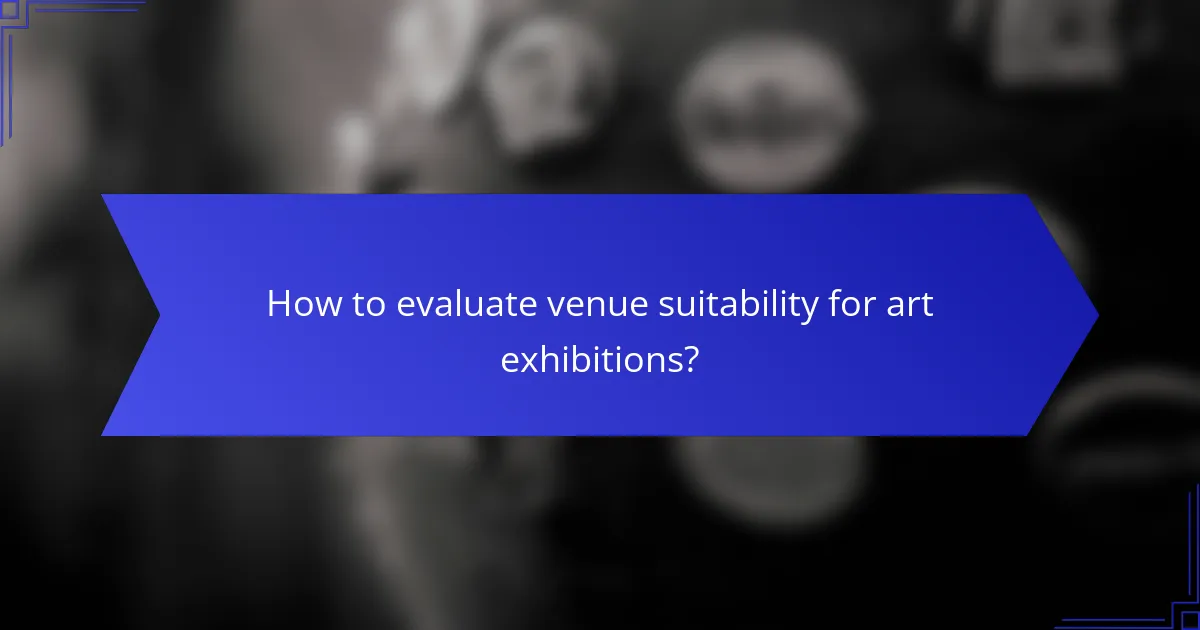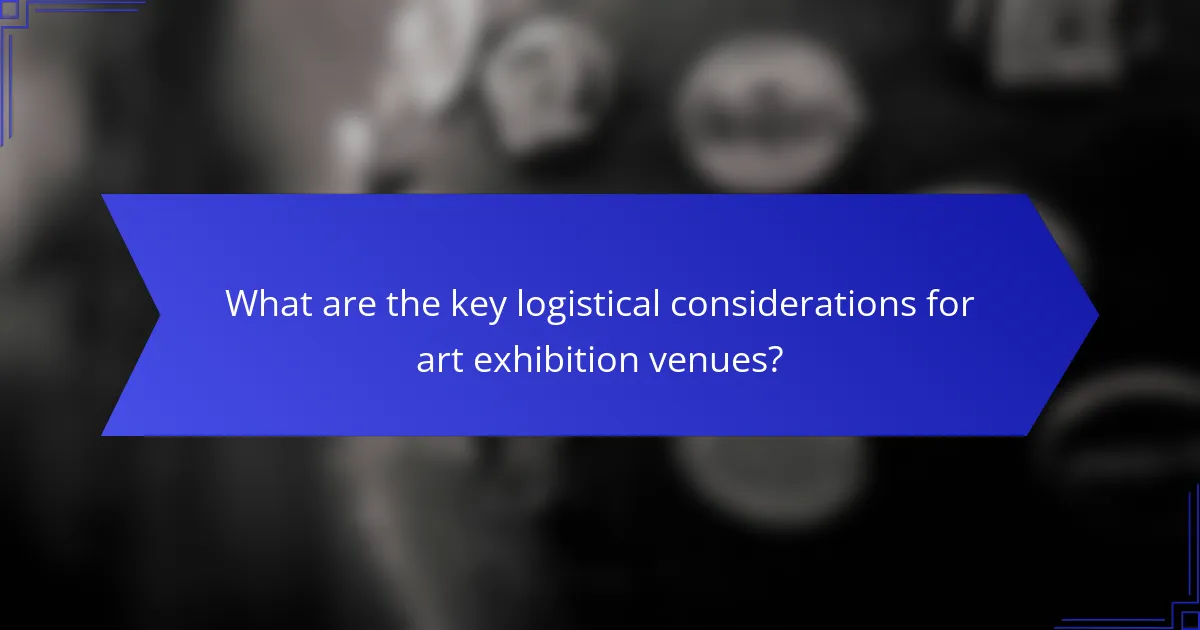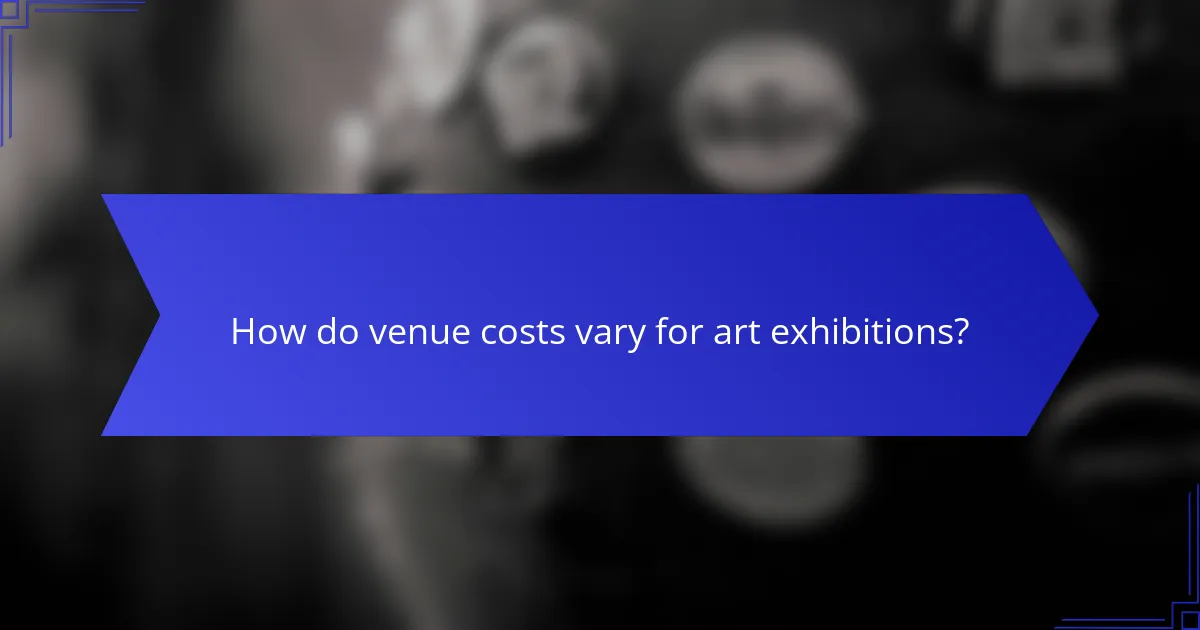Selecting the right venue for an art exhibition is critical to its success and involves careful consideration of several factors. Key elements such as location accessibility, space capacity, available facilities, and budget constraints must be evaluated to ensure alignment with the exhibition’s goals and audience needs. In cities like New York and Los Angeles, the choice of venue can significantly impact the exhibition’s reach and overall experience.

What factors influence venue selection for art exhibitions in New York?
Several key factors influence venue selection for art exhibitions in New York, including location accessibility, space capacity, available facilities, budget constraints, and the venue’s reputation. Each of these elements plays a crucial role in ensuring the exhibition’s success and attracting the desired audience.
Location accessibility
Location accessibility is vital for maximizing visitor attendance at art exhibitions. Venues should be situated near public transportation options, such as subway stations and bus stops, to facilitate easy access. Additionally, consider the availability of parking for those who prefer to drive.
Proximity to popular neighborhoods or cultural hubs can also enhance foot traffic. Venues located in areas with high pedestrian activity are more likely to attract spontaneous visitors.
Space capacity
Space capacity is a critical factor in venue selection, as it determines how many attendees can comfortably view the exhibition. Consider the expected number of visitors and the layout of the artwork when assessing capacity. A venue that is too small may lead to overcrowding, while an overly large space can feel empty.
For art exhibitions, a space that accommodates between 100 to 500 guests is often ideal, depending on the scale of the event. Ensure the layout allows for smooth flow and interaction with the artwork.
Facilities and amenities
Facilities and amenities play a significant role in enhancing the visitor experience at art exhibitions. Look for venues that offer essential services such as restrooms, climate control, and lighting options that highlight the artwork effectively. Accessibility features for individuals with disabilities are also crucial.
Additional amenities, such as catering services, Wi-Fi access, and audio-visual equipment, can further enrich the exhibition experience. Prioritize venues that can meet these needs to ensure a seamless event.
Cost and budget considerations
Cost and budget considerations are fundamental when selecting a venue for an art exhibition. Determine the total budget, including venue rental, insurance, and additional services, to avoid overspending. Venue costs in New York can vary widely, so it’s essential to compare options.
Consider negotiating rental fees or seeking venues that offer package deals, which may include additional services at a reduced rate. Always account for potential hidden costs, such as overtime fees or security deposits.
Reputation and past events
The reputation of a venue can significantly influence the perceived value of an art exhibition. Research past events held at the venue to gauge its suitability and success in hosting similar exhibitions. Venues with a strong track record often attract more attendees and media attention.
Engaging with previous exhibitors can provide insights into their experiences, helping you make an informed decision. A well-regarded venue can enhance the credibility of your exhibition and contribute to its overall success.

How to evaluate venue suitability for art exhibitions?
To evaluate venue suitability for art exhibitions, consider factors such as location, space configuration, accessibility, and facilities. A thorough assessment ensures the venue aligns with the exhibition’s goals and audience needs.
Site visits and inspections
Conducting site visits is essential for assessing a venue’s physical attributes and ambiance. Pay attention to the layout, lighting, and overall condition of the space. Take notes on how the venue can accommodate different types of artworks and installations.
During inspections, check for practical elements such as loading docks, storage areas, and restroom facilities. Ensure that the venue meets safety standards and has necessary permits for hosting public events.
Comparative analysis of venues
Perform a comparative analysis by listing potential venues and evaluating them against key criteria. Consider factors like size, location, rental costs, and available amenities. Create a scoring system to rank each venue based on how well they meet your exhibition’s requirements.
For example, if two venues are similar in size, compare their accessibility options and nearby attractions. This can influence foot traffic and overall visitor experience, which are crucial for a successful exhibition.
Feedback from previous exhibitors
Gather feedback from artists and organizations that have previously exhibited at the venues you are considering. Their insights can highlight strengths and weaknesses that may not be immediately apparent during your evaluation.
Ask specific questions about their experiences, such as the venue’s management responsiveness, audience turnout, and logistical support. This information can help you make a more informed decision about the venue’s suitability for your exhibition.

What are the best venues for art exhibitions in Los Angeles?
Los Angeles offers a variety of exceptional venues for art exhibitions, each with unique characteristics that cater to different artistic visions. The best venues combine accessibility, aesthetic appeal, and the ability to attract diverse audiences.
The Getty Center
The Getty Center is renowned for its stunning architecture and beautiful gardens, making it a premier choice for art exhibitions. It features a vast collection of European paintings, sculptures, and decorative arts, which can enhance the context of contemporary exhibitions.
When selecting The Getty Center, consider its capacity for large crowds and its location atop a hill, providing a picturesque view of Los Angeles. The venue also offers educational programs and resources that can complement exhibitions, making it a holistic choice for artists and curators.
MOCA (Museum of Contemporary Art)
MOCA specializes in contemporary art and is dedicated to showcasing innovative works from both established and emerging artists. With multiple locations, including the flagship museum in downtown Los Angeles, MOCA provides versatile spaces suitable for various exhibition formats.
When planning an exhibition at MOCA, take advantage of its strong community engagement and marketing support. The museum often collaborates with artists for unique projects, which can enhance visibility and attract a dedicated audience interested in contemporary trends.
Los Angeles County Museum of Art (LACMA)
LACMA is the largest art museum in the western United States, featuring a diverse collection that spans various cultures and time periods. This venue is ideal for exhibitions that aim to reach a broad audience due to its extensive visitor base and prominent location on Wilshire Boulevard.
Utilizing LACMA for an exhibition offers the benefit of established visitor traffic and extensive promotional opportunities. However, securing a date can be competitive, so early planning and flexibility with dates are essential for success.

What are the key logistical considerations for art exhibition venues?
Key logistical considerations for art exhibition venues include accessibility for loading and unloading, security measures to protect the artwork, and proper lighting and climate control to preserve the pieces. Each of these factors plays a crucial role in ensuring a successful exhibition experience for both the organizers and the attendees.
Loading and unloading access
Loading and unloading access is vital for the smooth setup and takedown of an exhibition. Venues should have designated areas for vehicles to park and unload materials, ideally close to the exhibition space to minimize transport time. Considerations include door sizes, ramp accessibility, and whether the venue can accommodate large trucks or vans.
Additionally, check if the venue has equipment like dollies or lifts to assist in moving heavy items. A venue with easy access can significantly reduce setup time and labor costs, making it a practical choice for exhibition planners.
Security measures
Security measures are essential to protect valuable artworks from theft or damage. Venues should have a comprehensive security plan that includes surveillance cameras, security personnel, and controlled access points. It’s advisable to inquire about the venue’s insurance policies and whether they cover artwork during the exhibition period.
Consider the venue’s location and surrounding area as well; a venue in a high-crime area may require additional security measures. Collaborating with local law enforcement for added security during the exhibition can also enhance safety.
Lighting and climate control
Proper lighting and climate control are crucial for preserving the integrity of the artwork. Venues should provide adjustable lighting options to highlight pieces without causing damage, such as UV-filtered lights. Additionally, maintaining a stable temperature and humidity level is important to prevent deterioration of sensitive materials.
When selecting a venue, assess its HVAC system to ensure it can handle the specific needs of the exhibition. For instance, artworks made of paper or textiles may require stricter climate control compared to sculptures. Always discuss these requirements with the venue management to ensure compliance with preservation standards.

How do venue costs vary for art exhibitions?
Venue costs for art exhibitions can vary significantly based on location, size, and amenities. Factors such as rental fees, additional services, and the duration of the event all contribute to the overall expenses.
Rental fees
Rental fees for exhibition venues can range widely, often from a few hundred to several thousand dollars per day. Urban venues in prime locations typically command higher rates compared to rural or less popular areas. For example, a gallery in a major city may charge between 1,000 and 5,000 USD per day, while smaller venues might range from 300 to 1,500 USD.
When considering rental fees, it’s essential to evaluate what is included in the price. Some venues may offer additional services like security, lighting, and setup, which can save costs in the long run. Always clarify whether utilities and insurance are part of the rental agreement.
To avoid unexpected expenses, create a checklist of all potential costs associated with the venue. This should include not just the rental fee but also deposits, cleaning fees, and any required permits. Understanding these elements will help in budgeting effectively for the exhibition.
